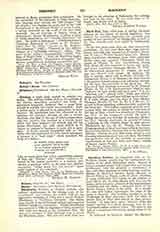

Bisomus, a tomb large enough to contain two bodies. The ordinary tombs (loci) in the galleries of the Roman catacombs contained one body. It sometimes happened, however, that a space large enough to contain two bodies was excavated. Such a double grave is referred to in inscriptions as locus bisomus. An inscription from the catacomb of St. Calixtus, for instance, informs us that a certain Boniface, who died at the age of twenty-three years and two months, was interred in a double grave which had been prepared for himself and for his father (Bonifacius, qui vixit annis XXIII et II (mens) es, positus in bisomum in pace, sibi et patr. suo). A fourth-century inscription tells of two ladies who had purchased, for their future interment, a bisomus in a “new crypt” which contained the body of a Saint:
IN CRYPTA NOBA RETRO SAN
CTUS EMERVM VIVAS BALER
RA ET SABINA MERUM LOC
V BISOM AB APRONS ET A
BIATORE
Like so many pious but rather superstitious persons of that age “Balerra” and “Sabina” wished to be buried in the closest proximity to a martyr, retro sanctos, a privilege which, as we learn from another inscription, “many desire but few receive” (quod multi cupiunt et rari accipiunt).
MAURICE M. HASSETT

